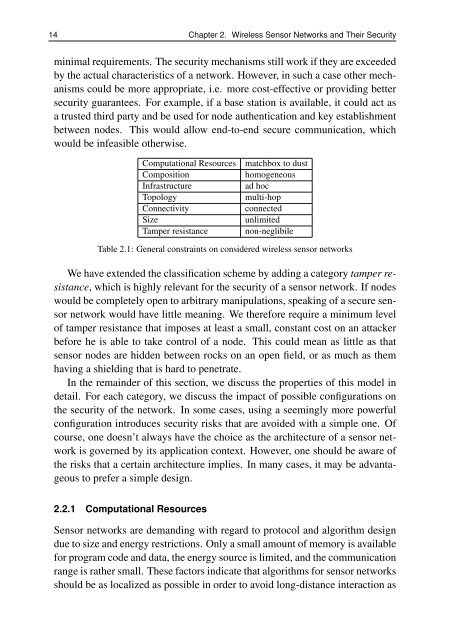Protocols for Secure Communication in Wireless Sensor Networks
Protocols for Secure Communication in Wireless Sensor Networks
Protocols for Secure Communication in Wireless Sensor Networks
You also want an ePaper? Increase the reach of your titles
YUMPU automatically turns print PDFs into web optimized ePapers that Google loves.
14 Chapter 2. <strong>Wireless</strong> <strong>Sensor</strong> <strong>Networks</strong> and Their Security<br />
m<strong>in</strong>imal requirements. The security mechanisms still work if they are exceeded<br />
by the actual characteristics of a network. However, <strong>in</strong> such a case other mechanisms<br />
could be more appropriate, i.e. more cost-effective or provid<strong>in</strong>g better<br />
security guarantees. For example, if a base station is available, it could act as<br />
a trusted third party and be used <strong>for</strong> node authentication and key establishment<br />
between nodes. This would allow end-to-end secure communication, which<br />
would be <strong>in</strong>feasible otherwise.<br />
Computational Resources matchbox to dust<br />
Composition homogeneous<br />
Infrastructure ad hoc<br />
Topology multi-hop<br />
Connectivity connected<br />
Size unlimited<br />
Tamper resistance non-neglibile<br />
Table 2.1: General constra<strong>in</strong>ts on considered wireless sensor networks<br />
We have extended the classification scheme by add<strong>in</strong>g a category tamper resistance,<br />
which is highly relevant <strong>for</strong> the security of a sensor network. If nodes<br />
would be completely open to arbitrary manipulations, speak<strong>in</strong>g of a secure sensor<br />
network would have little mean<strong>in</strong>g. We there<strong>for</strong>e require a m<strong>in</strong>imum level<br />
of tamper resistance that imposes at least a small, constant cost on an attacker<br />
be<strong>for</strong>e he is able to take control of a node. This could mean as little as that<br />
sensor nodes are hidden between rocks on an open field, or as much as them<br />
hav<strong>in</strong>g a shield<strong>in</strong>g that is hard to penetrate.<br />
In the rema<strong>in</strong>der of this section, we discuss the properties of this model <strong>in</strong><br />
detail. For each category, we discuss the impact of possible configurations on<br />
the security of the network. In some cases, us<strong>in</strong>g a seem<strong>in</strong>gly more powerful<br />
configuration <strong>in</strong>troduces security risks that are avoided with a simple one. Of<br />
course, one doesn’t always have the choice as the architecture of a sensor network<br />
is governed by its application context. However, one should be aware of<br />
the risks that a certa<strong>in</strong> architecture implies. In many cases, it may be advantageous<br />
to prefer a simple design.<br />
2.2.1 Computational Resources<br />
<strong>Sensor</strong> networks are demand<strong>in</strong>g with regard to protocol and algorithm design<br />
due to size and energy restrictions. Only a small amount of memory is available<br />
<strong>for</strong> program code and data, the energy source is limited, and the communication<br />
range is rather small. These factors <strong>in</strong>dicate that algorithms <strong>for</strong> sensor networks<br />
should be as localized as possible <strong>in</strong> order to avoid long-distance <strong>in</strong>teraction as
















